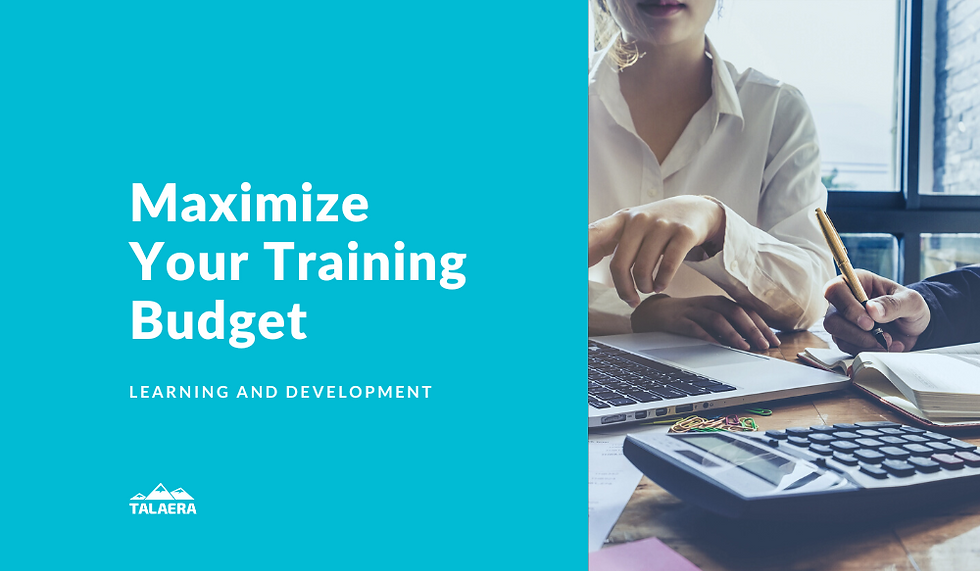
It’s that time of year again when HR and L&D teams around the world start thinking about how to make the most of their learning and development training budgets. With so many options and providers out there, it can be hard to know where to start. And with budgets being tighter than ever, it’s more important than ever to get it right. In this post, we’ll share some tips on how to make the most of your L&D training budget before it’s too late.
Why should you spend all your training budget?

When it comes to training and development, there are a lot of different options available. And with so many choices, it can be hard to know where to spend your money. But if you’re looking to get the most out of your training budget, here’s why you should spend it all on learning and development:
Use it or lose it
As the end of the fiscal year approaches, many organizations are scrambling to use up their remaining learning and development training budgets. Training budgets are allocated yearly and, if by the end of the year, you haven’t used it, you lose it. Since accumulating it is not an option, HR and L&D departments must make sure they’ve used up all their resources as the financial year comes to an end.
Invest in your employees
Your employees are your most valuable asset, so it only makes sense to invest in their development. By providing them with the training they need, you’re not only helping them grow as professionals, but you’re also investing in the future of your company.
Unlike other expenses, which are often seen as sunk costs, training can provide a return on investment (ROI). By spending your budget wisely on quality training programs, you can see a real impact on your organization’s bottom line.
Stay competitive
In today’s ever-changing business landscape, it’s important to stay ahead of the curve. And one way to do that is by ensuring that your employees have the latest skills and knowledge. By investing in their development, you’ll help keep your company competitive and future-proofed.
Become more agile and adaptable
Making the most of your training budget will make your workforce more adaptable to the new needs of the work market. The most successful companies will be the ones that adapt quickly and effectively. Continuous training keeps their knowledge fresh and skills sharp.
Attract top talent
Today’s workforce values development opportunities more than ever before. This means that, if you want to attract the top talent and retain your A-listers, you’ll need to invest in training.
Employees need to see the potential to grow, and they value that their employer is invested their personal and professional development. Growth and development opportunities are, in fact, one of the most important decision-making factors by job seekers nowadays.
Boost employee engagement
Organizations are starting to understand the importance of employee engagement. Investing in employee development creates opportunities for employees to feel excited about learning and growing. So give them the chance to develop their skills, learn new ones, and excel even more in their field. When your employees see that you’re investing in their growth, they become happy, loyal, and engaged in their work. This will give them a reason to turn a blind eye to new glossy job offers.
Increase customer satisfaction
Even with the emergence of chatbots and automated processes, chances are, some of your employees will still have to interact with customers. Sales, delivery services, or customer support will need excellent communication skills and ongoing training to ensure the highest satisfaction among your customers and potential clients.
How to make the most of your leftover training budget

If you’re like most learning and development professionals, you’re always looking for ways to spend that budget more effectively. Whether you have a limited training budget or a very generous one, it often happens that it doesn’t get used up. If you’re looking to get the most out of your L&D training budget, there are a few things you can do to make sure you’re using it the best way possible.
1. Assess your current situation
What’s working and what isn’t? Take a close look at your current training programs and initiatives. Are they really meeting the needs of your organization and employees? If not, it’s time to make some changes.
Don’t wait until the last minute to start thinking about training. By planning ahead, you’ll be able to identify specific areas that need improvement and design targeted training programs that will make the most impact.
2. Conduct a training needs analysis
A Training Needs Analysis (TNA) will help you identify the gaps in your current training offerings. Once you know where the gaps are, you can develop targeted training programs to fill them.
Talk to your employees and ask them what type of training they would like to see in the new year.
3. Set realistic goals
Before starting any training program, make sure you have a clear understanding of what you hope to achieve. This will help you evaluate whether or not the program is successful once it’s complete.
Once you know what needs to be improved, set some specific goals for your training programs. What do you want to achieve? Be sure to involve stakeholders in setting these goals so everyone is on the same page.
Then, make a plan for how you will implement new training programs in the coming year.
4. Find creative solutions
Don’t just throw money at the problem. Be creative in how you use your resources. There are many ways to deliver training without breaking the bank.
When it comes to learning and development, many organizations focus solely on traditional classroom-based training. However, this approach can be quite costly and may not always be the most effective way to learn. Instead of spending a large chunk of your L&D budget on classroom training, try something new and innovative that will really engage your employees and help them learn more effectively. Consider self-study, webinars, or even social media as delivery methods.
Research new training programs that can help improve productivity and meet your company’s goals.
Use existing resouces. There may already be some resources available within your organization that you can take advantage of. Before investing in new resources, explore what might already be available and see if it can meet your needs.
Whatever you do, make sure you’re taking advantage of your L&D budget before it’s too late. With a little creativity, you can design an L&D program that will really benefit your organization and its employees.
4. Make the program flexible
Employees’ schedules are often unpredictable, so find a program that offers flexibility in terms of when and how employees can complete the training.
5. Involve your employees
Get feedback from employees. Once you’ve narrowed down your choices, get feedback from employees about which program they would be most interested in taking and in which format. This will help ensure that they are engaged in the learning process and more likely to see results from the training.
Set up a mentoring program and try job shadowing. Some of the best trainers are already within your workforce. Pair employees proficient in a subject with others who need to work on that skill. Job shadowing implies spending time following a professional in that job, and it can last from just a few hours to several weeks. It helps your employees develop important cross-functional skills and open their chances of transferring to a different job within the same organization.
Invest in team-building activities. A team that learns together stays together. Organize activities where your employees get to know each other and teach each other. The bond they create will make your squad more robust and more ready to face obstacles together.
6. Evaluate regularly
As the saying goes, “data is king.” And when it comes to making the most out of your learning and development budget, data analytics is your best friend. By analyzing data related to your organization’s training needs, you can make informed decisions about where to allocate your resources for maximum impact.
As with any business initiative, it’s important to evaluate your training programs on a regular basis. This will help you determine what’s working and what isn’t so you can make necessary adjustments along the way.
Keep track of participants’ progress throughout the training program. This will give you a better idea of which parts of the program are working well and which need improvement.
7. Follow up and reflect
On a recent podcast interview with Lavinia Mehedintu, L&D expert and creator of Offbeat, on self-directed learning, Lavinia highlighted the importance of having the time to reflect and creating space to practice. There is a big difference between learning something new and implementing it. Integrating new skills and concepts requires time, but with today’s fast-paced lives it becomes as difficult as the learning itself.
Once the training program is over, follow up with participants to see how they’re doing and if they’re using what they learned. This feedback can be used to improve future training programs.
Top 6 corporate training programs for every employee

Investing in employee development is investing in your own success. The options can seem endless, but the following courses are essential to ensure your employees’ success not only at work but also in their personal lives. Here are six corporate training programs that every employee should take:
1. Leadership Development Training
Leadership training is essential, both for the individual and for the whole organization. As the old saying goes, “leadership is not a position, it’s an approach.”
By promoting your employees to leadership roles, you already understand their aptitudes, work ethics, and overall profile. However, they also need a varied skill set that allows them to excel in their new role. Help employees build their leadership skills with a program that covers topics like effective communication, conflict resolution, and team building. With leadership training, you will ensure increased productivity, nurture future leaders, and make your company more adaptable to change.
2. Project Management Training
A team with excellent project management skills is an efficient team. In a global market where employees have more autonomy than they did before, it is important that they have project management and time management under control. The benefits? Reduced stress, fewer missed deadlines, better work quality, and higher efficiency.
Give employees the skills they need to successfully manage projects with a program that covers topics like project planning, execution, and evaluation.
3. Communication Skills Training
Team bonding, prevention of misunderstandings, maximized quality of your customer service, professionalism, more and better deals… Do you need any more reasons to offer communications training to your workforce? Some courses include general business English communication, public speaking, technical writing, email writing, and negotiation skills, among others. Figure out what your team should work on and find the best program for them.
There are a variety of communications training programs available, so it’s important to do some research to find one that will fit the needs of your organization. Once you’ve found a program, be sure to allocate enough time and resources for employees to complete it. It’s important to note that communication skills training is not a one-time event. In order for it to be effective, employees need to be given opportunities to practice and receive feedback on a regular basis. Additionally, the training should be tailored to the specific needs of your organization and employees.
At Talaera, we believe in lifelong learning, and so we created this business English learning ecosystem where working professionals can improve their communication and culture skills with resources that match their needs, goals, and learning preferences. Not only through teacher-led sessions, but now also through self study.
4. Culture Training
Effective communication goes beyond knowing how to speak a language – culture plays a huge role. A person from the United States may not communicate the same way as a person from Germany, India, or Israel. Some cultures are more direct, others need more context, and others avoid saying no. Start by learning what topics to avoid in small talk and what these Americanisms mean. Cross-cultural communication skills can be the key that unlocks effective collaboration across cultures.
Culture training, also known as cross-cultural or intercultural training, refers to the process of increasing awareness among employees to acknowledge, appreciate, and adapt to every unique culture in the workplace. Help your employees develop their Cultural Intelligence (CQ), learn how different cultures communication, and ultimately improve collaboration across cultures.
5. Diversity and Inclusion Training
As the global workplace continues to become more diverse, it’s important that your L&D training budget reflects that. Diversity and inclusion training can help your employees understand and appreciate the differences in others, which can make your workplace more productive and cohesive.
Prepare employees for a diverse workforce with a program that covers topics like unconscious bias, inclusive language, inclusive hiring processes, and accessibility in the workplace, as well ass cultural competence and cross-cultural communication.
By investing in diversity and inclusion training, you’ll be sending a message to your employees that you value their individuality and contributions. This type of investment can pay off in a more engaged workforce and a more positive workplace culture.
6 . Data Analytics Training
Data analytics is one of the most in-demand skills today, and yet many organizations are still lagging behind when it comes to training their workforce in this area. Investing in data analytics training can help your organization gain a competitive edge, improve decision-making, and drive business growth.
How to pick the best training for your employees?

Training can feel expensive at times, but if done right, development programs can potentially give back the most to a company.
Positive aspects to look for in corporate training vendors:
When looking for the best training for your peeps, the following points will make a positive difference.
Personalization
Resources that reflect current needs and can be immediately applied
Flexibility
Engaging delivery
Access to online learning content and e-learning options
Variety of learning methods (video, audio, text, teacher-led sessions, self-directed learning, etc.)
User-friendly platform and easy access for employees
Experienced, qualified instructors
Low workload for employers and managers
Training analytics
Red flags to look out for:
Irrelevant or outdated content
No (or limited) training customization
Hidden costs
Inexperienced instructors
Poor training management
Lack of needs analysis
Too much work for managers
No training metrics
What can Talaera do for your organization?
At Talaera, we are firm believers in learning customization and lifelong learning, and so, we created this business English learning ecosystem where working professionals can improve their communication skills with resources that match their needs, goals, and learning preferences.
After listening to your communication and culture training needs, we will create a program tailored to your organization. Book a demo now.
For any additional information or questions, you can also reach out at hello@talaera.com. Interested in getting the best offers and receiving free content on Business English communication? Subscribe to our newsletter and we will keep you in the loop with offers, free events, and development materials!
If you enjoyed this article, keep reading:
What Americans Really Mean When They Say Things Like “How Are You?”
Working With Israelis? Use These 6 Excellent Communication Tips
The 6 Communication Tips Everyone Working With Germans Should Know
A Quick Guide To Asking Better Questions In Cross Cultural Workplaces
8 Tips On Direct Communication For Those Who Were Called “Too Direct”
13 Ways to Break Down Silos in the Workplace And Boost Collaboration
9 Tell-Tale Signs Your Employees Are Struggling With Cross-Cultural Communication
How To Overcome The Top 4 Communication Barriers In The Workplace
[Originally posted in 2019 and recently updated to make sure we keep bringing you relevant content every day.]



